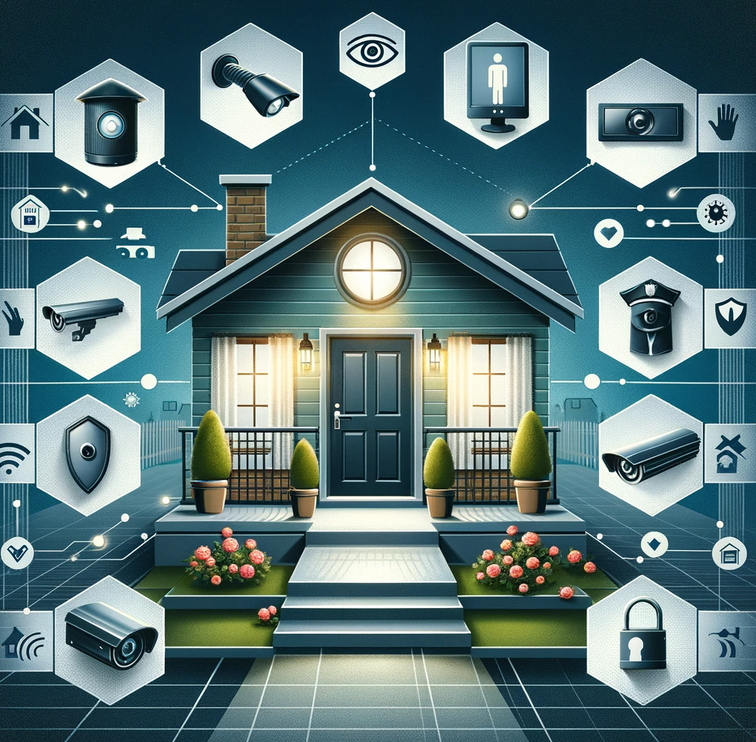Be Ready for the Unexpected Home Security Measures
Ensuring the safety and security of your home during a black swan event is paramount. Proper security measures can protect your family and your emergency supplies from potential threats. Here are comprehensive home security measures to implement:
Securing Entry Points
- Doors:
- Reinforced Doors: Install solid core or metal doors that are resistant to forced entry.
- Deadbolt Locks: Use high-quality deadbolt locks on all exterior doors. Consider double-cylinder deadbolts that require a key from both sides for added security.
- Door Jamb Reinforcement: Reinforce door frames and jambs with metal plates to prevent kick-ins.
- Smart Locks: Install smart locks with keyless entry and remote access features. These can provide alerts if someone attempts to tamper with the lock.
- Windows:
- Window Locks: Ensure all windows have strong, functioning locks. Install additional locking mechanisms for sliding windows.
- Security Film: Apply shatter-resistant security film to windows to prevent them from being easily broken.
- Window Bars: Consider installing decorative window bars or grilles on accessible windows, particularly those on the ground floor.
- Glass Break Sensors: Use sensors that detect the sound of breaking glass and trigger an alarm.
- Garage:
- Garage Door Security: Use a heavy-duty lock on your garage door. Install a manual lock on the inside for additional security when you are home.
- Motion Sensors: Install motion sensor lights around the garage and driveway to deter intruders.
- Garage Windows: Cover garage windows with curtains or frosted film to prevent outsiders from seeing inside.
Alarm Systems
- Burglar Alarms:
- Comprehensive Systems: Invest in a burglar alarm system with door/window sensors, motion detectors, and glass break sensors.
- Monitoring Services: Choose a system with professional monitoring services that can alert authorities if an alarm is triggered.
- Mobile Alerts: Ensure the system can send alerts to your mobile phone, allowing you to monitor your home remotely.
- Security Cameras:
- Placement: Install security cameras at key points around your property, including entryways, driveways, and common areas.
- Visibility: Make some cameras visible to deter potential intruders, while keeping others hidden for capturing unanticipated angles.
- Recording: Opt for cameras with high-resolution recording and night vision capabilities. Ensure recordings are saved to a secure, off-site location or cloud service.
Lighting
- Exterior Lighting:
- Motion-Activated Lights: Install motion-activated lights around the perimeter of your home to deter intruders and provide visibility.
- Continuous Lighting: Use dusk-to-dawn lights that automatically turn on at night and off during the day for consistent illumination.
- Interior Lighting:
- Smart Lighting: Use smart light bulbs and timers to create the appearance of occupancy, even when you are not home.
- Layered Lighting: Ensure multiple layers of lighting within your home to eliminate dark corners where intruders could hide.
Fencing and Landscaping
- Fencing:
- Secure Fencing: Install a sturdy fence around your property. Ensure gates are lockable and kept secure.
- Height and Visibility: Choose fencing that is tall enough to deter intruders but does not provide hiding spots. Avoid solid fences that block your view of the outside.
- Landscaping:
- Trimmed Hedges: Keep bushes and hedges trimmed to reduce hiding spots for intruders.
- Thorny Plants: Plant thorny or prickly bushes near windows and fence lines to deter climbing.
- Clear Pathways: Maintain clear pathways and remove any obstacles that could be used for hiding or climbing.
Community and Neighborhood Watch
- Neighborhood Watch:
- Participation: Join or establish a neighborhood watch program to promote community awareness and mutual protection.
- Communication: Maintain open lines of communication with your neighbors about any suspicious activities or concerns.
- Community Resources:
- Local Authorities: Stay informed about the resources and support offered by local law enforcement and emergency services.
- Social Networks: Utilize social media platforms and community forums to stay connected with neighbors and share information.
Emergency Preparedness
- Emergency Contacts:
- List: Keep a list of emergency contacts, including local law enforcement, fire departments, medical services, and trusted neighbors.
- Accessibility: Ensure this list is easily accessible to all family members.
- Drills and Training:
- Regular Drills: Conduct regular security drills to ensure all family members know how to respond in case of an emergency.
- Self-Defense: Consider self-defense training for family members to enhance personal safety.
- Supply Security:
- Secure Storage: Keep emergency supplies in a locked, secure area within your home.
- Inventory: Maintain an inventory of all supplies and regularly check for tampering or depletion.
By implementing these home security measures, you can significantly enhance the safety and resilience of your home against potential threats during a black swan event. Taking proactive steps to secure your property, communicate with your community, and prepare for emergencies will provide peace of mind and ensure that you and your family are protected.





Black Swan events are highly unpredictable and rare events that can have severe and widespread impacts. Here are some examples of black swan events that could cause food shortages:
Each of these events, while unlikely on their own, represents a potential threat that could lead to significant food shortages if they were to occur. Preparing for such events involves building resilient food systems, maintaining emergency food supplies, and ensuring robust infrastructure and response plans

Natural Disasters
Severe Weather Events:
Hurricanes and Typhoons: Can destroy crops, disrupt transportation, and damage infrastructure.
Floods: Can inundate farmlands, contaminate water supplies, and lead to loss of livestock.
Droughts: Prolonged periods of insufficient rainfall can devastate crop yields and reduce water supplies for irrigation.
Earthquakes:
Can damage agricultural infrastructure, disrupt transportation networks, and cause soil liquefaction in farming areas.
Volcanic Eruptions:
Can cover large areas of farmland with ash, disrupt air travel, and affect climate patterns, leading to lower crop yields.
Tsunamis:
Can flood coastal agricultural areas, destroy crops, and contaminate freshwater sources with saltwater.

Environmental and Ecological Events
Pandemics Affecting Humans:
Similar to COVID-19, can disrupt food production, supply chains, and labor availability in agriculture.
Plant Diseases and Pests:
Outbreaks of plant diseases (e.g., wheat rust) or pests (e.g., locust swarms) can devastate crops over large areas.
Animal Diseases:
Epidemics like avian influenza or African swine fever can drastically reduce livestock populations.

Geopolitical and Economic Events
Wars and Conflicts:
Can disrupt agricultural production, damage infrastructure, and displace farming communities.
Trade Disruptions:
Trade wars, sanctions, or blockades can restrict the flow of food commodities between countries.
Economic Collapses:
Severe economic downturns or financial crises can reduce the ability of countries to import food and affect agricultural investments.

Technological and Cyber Events
Cyberattacks:
Targeting critical infrastructure such as power grids, transportation networks, or food supply chains can cause significant disruptions.
Biotechnology Failures:
Unintended consequences of genetically modified organisms (GMOs) or other agricultural technologies can lead to crop failures or health issues.

Climate Change-Related Events
Abrupt Climate Shifts:
Sudden and severe changes in climate patterns, such as an unexpected shift in the jet stream, can affect growing seasons and crop viability.
Oceanic Changes:
Rapid changes in ocean temperatures or currents can affect global weather patterns and fish populations, leading to food shortages.

Societal and Infrastructure Events
Abrupt Climate Shifts:
Sudden and severe changes in climate patterns, such as an unexpected shift in the jet stream, can affect growing seasons and crop viability.
Oceanic Changes:
Rapid changes in ocean temperatures or currents can affect global weather patterns and fish populations, leading to food shortages.

Other Unpredictable Events
Asteroid Impact:
Though extremely rare, an asteroid impact could cause widespread devastation and climate disruptions.
Solar Flares and EMPs:
Severe solar flares or electromagnetic pulses (EMPs) could disrupt electrical grids and communication systems, affecting food production and distribution.

